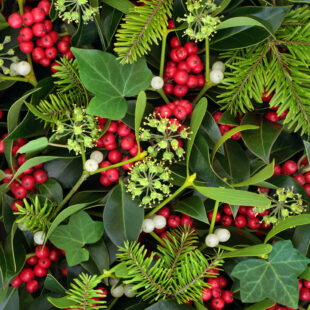
Although you could splurge on red roses when decorating for the holidays, there are other, less expensive, natural alternatives. The early Romans decorated with holly for the winter solstice. Holly, along with ivy and mistletoe, was a traditional Christmas decoration in England, and early American settlers also preferred to use objects from nature to decorate for the holidays.
While it is quite popular at Christmas, unfortunately mistletoe is difficult to harvest. The vine is semi-parasitic and grows high up in trees. The easiest way to get a branch is to buy a fake piece in a craft shop, which rather destroys the illusion of a natural theme. However, if you are angling to be kissed under it, you may decide that pragmatism outranks purism.

Fortunately, holly and ivy abound in gardens and are easy to harvest. If you are fortunate enough to have holly with red berries growing in your yard, it is easy to cut the branches, put them in a vase, and tie with a red ribbon. This makes a pretty gift for neighbors who do not have their own holly. One can also make a swag of evergreen and holly branches. Cut the stems long, bundle them together with a sturdy rubber band, tie a red or tartan bow around the stems, and hang downward from a nail on the door.
Evergreen and holly foliage also make excellent table centerpieces. Soak a piece of floral foam in water, place it in a low container, and stick short stems of evergreen and holly into the foam until it is covered. You can also add a couple of Christmas balls, pine cones, and store-bought red carnations, which will last well.
If you are interested in natural decorations, you may want to invest in holly bushes. There are two kinds—deciduous and evergreen. The deciduous kind lose their leaves in winter, but if the birds don’t get them all, some of the red berries remain on the bush. Choose the native Winterberry holly bush that grows about 6 feet tall in our climate. The brilliant red berries light up the landscape from late September through February. You will need male plants to pollinate the female plants. Some possibilities are ‘Winter Red,’ which is pollinated by ‘Southern Gentleman,’ or the more compact, 4-foot-tall ‘Red Sprite,’ pollinated by ‘Apollo.’ For evergreen holly, which has the bonus of lustrous leaves that showcase the red berries on the female, choose our native Ilex opaca.
Holly likes moist, acidic soil but will grow in clay. You can boost the soil acidity by mixing 5 tablespoons of Miracle-Gro Miracid plant food in a 5-gallon bucket of water to improve the pH of the soil. Pour it within the plant’s dripline each spring. I also suggest buying your holly plants from one of our excellent Bloomington nurseries as the locals know the varieties that will suit your space best.
The holly and the ivy.
When they are both full grown,
Of all the trees that are in the wood,
The holly bears the crown.
Traditional Carol











